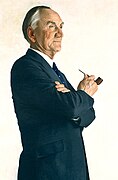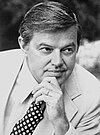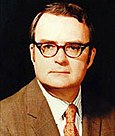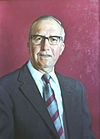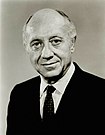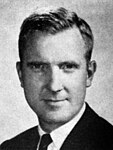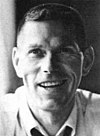1968 United States Senate elections
| ||||||||||||||||||||||||||||||||||||||||
34 of the 100 seats in the United States Senate 51 seats needed for a majority | ||||||||||||||||||||||||||||||||||||||||
|---|---|---|---|---|---|---|---|---|---|---|---|---|---|---|---|---|---|---|---|---|---|---|---|---|---|---|---|---|---|---|---|---|---|---|---|---|---|---|---|---|
| ||||||||||||||||||||||||||||||||||||||||
 Results of the elections: Democratic gain Democratic hold Republican gain Republican hold No election | ||||||||||||||||||||||||||||||||||||||||
| ||||||||||||||||||||||||||||||||||||||||
The 1968 United States Senate elections were elections for the United States Senate. Held on November 5, the 34 seats of Class 3 were contested in regular elections. They coincided with the presidential election of the same year. The Republicans picked up five net seats in the Senate. This saw Republicans win a Senate seat in Florida for the first time since Reconstruction.
Republicans would gain another seat after the election when Alaska Republican Ted Stevens was appointed to replace Democrat Bob Bartlett, reducing Democrats' majority to 57–43.
Results summary
[edit]| 58 | 42 |
| Democratic | Republican |
| Parties | Total | ||||||||||||||||||||||||||||||||||||||||||||||||||||||||||||||||||||||||||||||||||||||||||||||||||
|---|---|---|---|---|---|---|---|---|---|---|---|---|---|---|---|---|---|---|---|---|---|---|---|---|---|---|---|---|---|---|---|---|---|---|---|---|---|---|---|---|---|---|---|---|---|---|---|---|---|---|---|---|---|---|---|---|---|---|---|---|---|---|---|---|---|---|---|---|---|---|---|---|---|---|---|---|---|---|---|---|---|---|---|---|---|---|---|---|---|---|---|---|---|---|---|---|---|---|---|
| Democratic | Republican | Conservative | Other | ||||||||||||||||||||||||||||||||||||||||||||||||||||||||||||||||||||||||||||||||||||||||||||||||
| Last elections (1966) | 64 | 36 | 0 | 0 | 100 | ||||||||||||||||||||||||||||||||||||||||||||||||||||||||||||||||||||||||||||||||||||||||||||||
| Before these elections | 63 | 37 | 0 | 0 | 100 | ||||||||||||||||||||||||||||||||||||||||||||||||||||||||||||||||||||||||||||||||||||||||||||||
| Not up | 40 | 26 | 0 | 0 | 66 | ||||||||||||||||||||||||||||||||||||||||||||||||||||||||||||||||||||||||||||||||||||||||||||||
| Up Class 3 (1962→1968) |
23 | 11 | 0 | 0 | 34 | ||||||||||||||||||||||||||||||||||||||||||||||||||||||||||||||||||||||||||||||||||||||||||||||
| Incumbent retired | 3 | 3 | — | — | 6 | ||||||||||||||||||||||||||||||||||||||||||||||||||||||||||||||||||||||||||||||||||||||||||||||
| Held by same party | 1 | 2 | — | — | 3 | ||||||||||||||||||||||||||||||||||||||||||||||||||||||||||||||||||||||||||||||||||||||||||||||
| Replaced by other party | — | — | 3 | ||||||||||||||||||||||||||||||||||||||||||||||||||||||||||||||||||||||||||||||||||||||||||||||||
| Result | 2 | 4 | 0 | 0 | 6 | ||||||||||||||||||||||||||||||||||||||||||||||||||||||||||||||||||||||||||||||||||||||||||||||
| Incumbent ran | 20 | 8 | — | — | 28 | ||||||||||||||||||||||||||||||||||||||||||||||||||||||||||||||||||||||||||||||||||||||||||||||
| Won re-election | 13 | 7 | — | — | 20 | ||||||||||||||||||||||||||||||||||||||||||||||||||||||||||||||||||||||||||||||||||||||||||||||
| Lost re-election | — | — | 4 | ||||||||||||||||||||||||||||||||||||||||||||||||||||||||||||||||||||||||||||||||||||||||||||||||
| Lost renomination, but held by same party |
2 | 0 | — | — | 2 | ||||||||||||||||||||||||||||||||||||||||||||||||||||||||||||||||||||||||||||||||||||||||||||||
| Lost renomination, and party lost |
— | — | 2 | ||||||||||||||||||||||||||||||||||||||||||||||||||||||||||||||||||||||||||||||||||||||||||||||||
| Result | 16 | 12 | 0 | 0 | 28 | ||||||||||||||||||||||||||||||||||||||||||||||||||||||||||||||||||||||||||||||||||||||||||||||
| Total elected | 18 | 16 | 0 | 0 | 34 | ||||||||||||||||||||||||||||||||||||||||||||||||||||||||||||||||||||||||||||||||||||||||||||||
| Net gain/loss | 5 | ||||||||||||||||||||||||||||||||||||||||||||||||||||||||||||||||||||||||||||||||||||||||||||||||||
| Nationwide vote | 24,976,660 | 23,588,832[b] | 1,139,402 | 989,058 | 50,693,952 | ||||||||||||||||||||||||||||||||||||||||||||||||||||||||||||||||||||||||||||||||||||||||||||||
| Share | 49.27% | 46.53% | 2.25% | 1.95% | 100% | ||||||||||||||||||||||||||||||||||||||||||||||||||||||||||||||||||||||||||||||||||||||||||||||
| Result | 58[a] | 42 | 0 | 0 | 100 | ||||||||||||||||||||||||||||||||||||||||||||||||||||||||||||||||||||||||||||||||||||||||||||||
Source: Clerk of the U.S. House of Representatives[1]
Gains, losses, and holds
[edit]Retirements
[edit]Three Republicans and three Democrats retired instead of seeking re-election.
Defeats
[edit]One Republican and seven Democrats sought re-election but lost in the primary or general election.
Post-election changes
[edit]One Democrat died on December 11, 1968, and a Republican was appointed on December 24, 1968.
| State | Senator | Replaced by |
|---|---|---|
| Alaska (Class 2) |
Bob Bartlett | Ted Stevens |
| Illinois (Class 3) |
Everett Dirksen | Ralph Tyler Smith |
Change in composition
[edit]Before the elections
[edit]After the September 10, 1968 appointment in New York.
| D1 | D2 | D3 | D4 | D5 | D6 | D7 | D8 | D9 | D10 |
| D20 | D19 | D18 | D17 | D16 | D15 | D14 | D13 | D12 | D11 |
| D21 | D22 | D23 | D24 | D25 | D26 | D27 | D28 | D29 | D30 |
| D40 | D39 | D38 | D37 | D36 | D35 | D34 | D33 | D32 | D31 |
| D41 Ala. Retired |
D42 Ak. (cl. 3) Ran |
D43 Ariz. Retired |
D44 Ark. Ran |
D45 Conn. Ran |
D46 Fla. Retired |
D47 Ga. Ran |
D48 Hawaii Ran |
D49 Idaho Ran |
D50 Ind. Ran |
| Majority → | D51 La. Ran | ||||||||
| D60 S.C. Ran |
D59 Pa. Ran |
D58 Ore. Ran |
D57 Okla. Ran |
D56 Ohio Ran |
D55 N.C. Ran |
D54 Nev. Ran |
D53 Mo. Ran |
D52 Md. Ran | |
| D61 S.D. Ran |
D62 Wash. Ran |
D63 Wisc. Ran |
R37 Vt. Ran |
R36 Utah Ran |
R35 N.D. Ran |
R34 N.Y. (cl. 3) Ran |
R33 N.H. Ran |
R32 Ky. Ran |
R31 Kan. Retired |
| R21 | R22 | R23 | R24 | R25 | R26 | R27 Calif. Ran |
R28 Colo. Ran |
R29 Ill. Ran |
R30 Iowa Retired |
| R20 | R19 | R18 | R17 | R16 | R15 | R14 | R13 | R12 | R11 |
| R1 N.Y. (cl. 1) Gain |
R2 | R3 | R4 | R5 | R6 | R7 | R8 | R9 | R10 |
After the general elections
[edit]| D1 | D2 | D3 | D4 | D5 | D6 | D7 | D8 | D9 | D10 |
| D20 | D19 | D18 | D17 | D16 | D15 | D14 | D13 | D12 | D11 |
| D21 | D22 | D23 | D24 | D25 | D26 | D27 | D28 | D29 | D30 |
| D40 | D39 | D38 | D37 | D36 | D35 | D34 | D33 | D32 | D31 |
| D41 Ala. Hold |
D42 Ak. (cl. 3) Hold |
D43 Ark. Re-elected |
D44 Conn. Re-elected |
D45 Ga. Re-elected |
D46 Hawaii Re-elected |
D47 Idaho Re-elected |
D48 Ind. Re-elected |
D49 La. Re-elected |
D50 Mo. Hold |
| Majority → | D51 Nev. Re-elected | ||||||||
| R41 Ore. Gain |
R42 Pa. Gain |
D58 Iowa Gain |
D57 Calif. Gain |
D56 Wisc. Re-elected |
D55 Wash. Re-elected |
D54 S.D. Re-elected |
D53 S.C. Re-elected |
D52 N.C. Re-elected | |
| R40 Okla. Gain |
R39 Ohio Gain |
R38 Md. Gain |
R37 Fla. Gain |
R36 Ariz. Gain |
R35 Vt. Re-elected |
R34 Utah Re-elected |
R33 N.D. Re-elected |
R32 N.Y. (cl. 3) Re-elected |
R31 N.H. Re-elected |
| R21 | R22 | R23 | R24 | R25 | R26 | R27 Colo. Re-elected |
R28 Ill. Re-elected |
R29 Kan. Hold |
R30 Ky. Hold |
| R20 | R19 | R18 | R17 | R16 | R15 | R14 | R13 | R12 | R11 |
| R1 | R2 | R3 | R4 | R5 | R6 | R7 | R8 | R9 | R10 |
Beginning of the next Congress
[edit]| D1 | D2 | D3 | D4 | D5 | D6 | D7 | D8 | D9 | D10 |
| D20 | D19 | D18 | D17 | D16 | D15 | D14 | D13 | D12 | D11 |
| D21 | D22 | D23 | D24 | D25 | D26 | D27 | D28 | D29 | D30 |
| D40 | D39 | D38 | D37 | D36 | D35 | D34 | D33 | D32 | D31 |
| D41 | D42 | D43 | D44 | D45 | D46 | D47 | D48 | D49 | D50 |
| Majority → | D51 | ||||||||
| R41 | R42 | R43 Ak. (cl. 2) Gain |
D57 | D56 | D55 | D54 | D53 | D52 | |
| R40 | R39 | R38 | R37 | R36 | R35 | R34 | R33 | R32 | R31 |
| R21 | R22 | R23 | R24 | R25 | R26 | R27 | R28 | R29 | R30 |
| R20 | R19 | R18 | R17 | R16 | R15 | R14 | R13 | R12 | R11 |
| R1 | R2 | R3 | R4 | R5 | R6 | R7 | R8 | R9 | R10 |
| Key: |
|
|---|
Race summary
[edit]Elections leading to the next Congress
[edit]In these general elections, the winners were elected for the term beginning January 3, 1969; ordered by state.
All of the elections involved the Class 3 seats.
| State (linked to summaries below) |
Incumbent | Results | Candidates | ||
|---|---|---|---|---|---|
| Senator | Party | Electoral history | |||
| Alabama | J. Lister Hill | Democratic | 1938 (Appointed) 1938 1944 1950 1956 1962 |
Incumbent retired. New senator elected. Democratic hold. |
|
| Alaska | Ernest Gruening | Democratic | 1958 1962 |
Incumbent lost renomination, then ran as a write-in candidate but lost re-election. New senator elected. Democratic hold. |
|
| Arizona | Carl Hayden | Democratic | 1926 1932 1938 1944 1950 1956 1962 |
Incumbent retired. New senator elected. Republican gain. |
|
| Arkansas | J. William Fulbright | Democratic | 1944 1950 1956 1962 |
Incumbent re-elected. |
|
| California | Thomas Kuchel | Republican | 1953 (Appointed) 1954 (special) 1956 1962 |
Incumbent lost renomination. New senator elected. Democratic gain. |
|
| Colorado | Peter H. Dominick | Republican | 1962 | Incumbent re-elected. |
|
| Connecticut | Abraham Ribicoff | Democratic | 1962 | Incumbent re-elected. |
|
| Florida | George Smathers | Democratic | 1950 1956 1962 |
Incumbent retired. New senator elected. Republican gain. |
|
| Georgia | Herman Talmadge | Democratic | 1956 1962 |
Incumbent re-elected. |
|
| Hawaii | Daniel Inouye | Democratic | 1962 | Incumbent re-elected. |
|
| Idaho | Frank Church | Democratic | 1956 1962 |
Incumbent re-elected. |
|
| Illinois | Everett Dirksen | Republican | 1950 1956 1962 |
Incumbent re-elected. |
|
| Indiana | Birch Bayh | Democratic | 1962 | Incumbent re-elected. |
|
| Iowa | Bourke B. Hickenlooper | Republican | 1944 1950 1956 1962 |
Incumbent retired. New senator elected. Democratic gain. |
|
| Kansas | Frank Carlson | Republican | 1950 (special) 1950 1956 1962 |
Incumbent retired. New senator elected. Republican hold. |
|
| Kentucky | Thruston Ballard Morton | Republican | 1956 1962 |
Incumbent retired. New senator elected. Republican hold. Incumbent resigned December 16, 1968 to give successor preferential seniority. Winner appointed December 17, 1968. |
|
| Louisiana | Russell B. Long | Democratic | 1948 (special) 1950 1956 1962 |
Incumbent re-elected. |
|
| Maryland | Daniel Brewster | Democratic | 1962 | Incumbent lost re-election. New senator elected. Republican gain. |
|
| Missouri | Edward V. Long | Democratic | 1960 (Appointed) 1960 (special) 1962 |
Incumbent lost renomination. New senator elected. Democratic hold. Incumbent resigned December 27, 1968 to give successor preferential seniority. Winner appointed December 28, 1968. |
|
| Nevada | Alan Bible | Democratic | 1954 (special) 1956 1962 |
Incumbent re-elected. |
|
| New Hampshire | Norris Cotton | Republican | 1954 (special) 1956 1962 |
Incumbent re-elected. |
|
| New York | Jacob Javits | Republican | 1956 1962 |
Incumbent re-elected. |
|
| North Carolina | Sam Ervin | Democratic | 1954 (special) 1954 (Appointed) 1956 1962 |
Incumbent re-elected. |
|
| North Dakota | Milton Young | Republican | 1945 (Appointed) 1946 (special) 1950 1956 1962 |
Incumbent re-elected. |
|
| Ohio | Frank Lausche | Democratic | 1956 1962 |
Incumbent lost renomination. New senator elected. Republican gain. |
|
| Oklahoma | Mike Monroney | Democratic | 1950 1956 1962 |
Incumbent lost re-election. New senator elected. Republican gain. |
|
| Oregon | Wayne Morse | Democratic | 1944 1950 1956 1962 |
Incumbent lost re-election. New senator elected. Republican gain. |
|
| Pennsylvania | Joseph S. Clark Jr. | Democratic | 1956 1962 |
Incumbent lost re-election. New senator elected. Republican gain. |
|
| South Carolina | Fritz Hollings | Democratic | 1966 (special) | Incumbent re-elected. |
|
| South Dakota | George McGovern | Democratic | 1962 | Incumbent re-elected. |
|
| Utah | Wallace F. Bennett | Republican | 1950 1956 1962 |
Incumbent re-elected. |
|
| Vermont | George Aiken | Republican | 1940 (special) 1944 1950 1956 1962 |
Incumbent re-elected. |
|
| Washington | Warren Magnuson | Democratic | 1944 (Appointed) 1944 1950 1956 1962 |
Incumbent re-elected. |
|
| Wisconsin | Gaylord Nelson | Democratic | 1962 | Incumbent re-elected. |
|
Closest races
[edit]Fifteen races had a margin of victory under 10%:
| State | Party of winner | Margin |
|---|---|---|
| Oregon | Republican (flip) | 0.4% |
| Iowa | Democratic (flip) | 0.6% |
| Missouri | Democratic | 2.2% |
| Ohio | Republican (flip) | 3.0% |
| Indiana | Democratic | 3.5% |
| Kentucky | Republican | 3.8% |
| California | Democratic (flip) | 4.9% |
| Oklahoma | Republican (flip) | 5.5% |
| Pennsylvania | Republican (flip) | 6.1% |
| Illinois | Republican | 6.4% |
| Alaska | Democratic | 7.7% |
| Utah | Republican | 7.9% |
| Connecticut | Democratic | 8.6% |
| Maryland | Republican (flip) | 8.7% |
| Nevada | Democratic | 9.6% |
Arkansas was the tipping point state with a margin of 18.3%.
Alabama
[edit]
| |||||||||||||||||||||
 County results Allen: 40–50% 50–60% 60–70% 70–80% 80–90% >90% Hooper: 40-50% Schwenn: 40–50% | |||||||||||||||||||||
| |||||||||||||||||||||
After electing Republicans post-Reconstruction, Alabama had historically voted Democratic in local, state, and presidential elections from the 1870s until the 1960s with the passage of the Civil Rights Act. However, in 1948 Alabama did not support the Democratic ticket for the first time in nearly 100 years, voting for Strom Thurmond, who ran a third-party campaign. Democrats lost ground due to the unpopularity of the Civil Rights Act among white voters, who at the time comprised nearly the entire electorate. In 1964, Barry Goldwater became the first Republican to win the state of Alabama since Ulysses Grant, while the state elected Republicans to its congressional delegation for the first time since the turn of the century. Goldwater voted against the Civil Rights Act, which boosted his popularity in Southern states.
In 1962, J. Lister Hill ran for re-election to this seat to a fifth term but faced an unusually close race against Republican James D. Martin, who came within 1% of unseating the incumbent. In 1968, Republicans looked to build upon their momentum but faced a challenge when Lieutenant Governor James B. Allen, a staunch conservative, was nominated by the Democratic Party. Republicans also failed to capitalize on the candidacy of liberal Democrat Hubert H. Humphrey due to the third-party candidacy of Governor George Wallace limiting Republican support. Allen defeated Republican Perry Hooper by a wide margin in the general election and faced little opposition in 1978.
| Party | Candidate | Votes | % | |
|---|---|---|---|---|
| Democratic | James Allen | 638,774 | 69.71 | |
| Republican | Perry O. Hooper Sr. | 201,227 | 21.96 | |
| National Democratic (Ala.) | Robert Schwenn | 76,299 | 8.33 | |
| Majority | 437,547 | 47.75 | ||
| Turnout | 916,300 | |||
| Democratic hold | ||||
Alaska
[edit]
| |||||||||||||||||||||
 Results by state house district Gravel: 40–50% 50–60% 60–70% Gruening: 30–40% | |||||||||||||||||||||
| |||||||||||||||||||||
Democrat Ernest Gruening had served as one of the state's inaugural senators alongside Democrat Bob Bartlett since 1959. He was re-elected in a landslide victory in 1962. In 1968, he was challenged by former Speaker of the Alaska House of Representatives, Mike Gravel, who ran on a campaign of youth.[3] Gravel upset Gruening in the Democratic primary with just under 53% of the vote to 47% for Gruening.
Gravel faced former Anchorage Mayor Republican Elmer E. Rasmuson in the general election, while Gruening ran a write-in campaign. Gravel won a three-way race with 45% of the vote to 37% for Rasmuson, with incumbent Gruening scoring 17%.
| Party | Candidate | Votes | % | |
|---|---|---|---|---|
| Democratic | Mike Gravel | 36,527 | 45.13 | |
| Republican | Elmer E. Rasmuson | 30,286 | 37.42 | |
| Write-in | Ernest Gruening (Incumbent) | 14,118 | 17.44 | |
| Majority | 6,241 | 7.71 | ||
| Turnout | 80,931 | |||
| Democratic hold | ||||
Two months after the election, on December 11, 1968, the other Alaskan senator, Democrat Bob Bartlett, died. Republican Ted Stevens, who lost the Republican primary to Rasmuson for this seat, was then appointed to that other seat.
Arizona
[edit]
| |||||||||||||||||
 County results Goldwater: 50–60% 60–70% Elson: 50–60% 60–70% 70–80% | |||||||||||||||||
| |||||||||||||||||
Incumbent Democrat Carl Hayden did not run for re-election to an eighth term, with his long-time staff member Roy Elson running as the Democratic Party nominee to replace him. Elson beat State Treasurer of Arizona Bob Kennedy in the primary.
| Party | Candidate | Votes | % | |
|---|---|---|---|---|
| Democratic | Roy Elson | 95,231 | 62.78 | |
| Democratic | Bob Kennedy | 41,397 | 27.29 | |
| Democratic | Dick Herbert | 15,061 | 9.93 | |
| Turnout | 151,689 | 43.18 | ||
Elson was defeated by a wide margin, however, by former U.S. senator and Republican presidential nominee Barry Goldwater. Prior to Goldwater's election, the seat had been held for decades by the Democratic Party under Carl Hayden, and would remain under Republican Party control until 2020. Elson had previously challenged U.S. senator Paul Fannin in 1964, when Goldwater vacated his seat to run for President against Lyndon B. Johnson.
| Party | Candidate | Votes | % | |
|---|---|---|---|---|
| Republican | Barry Goldwater | 274,607 | 57.22 | |
| Democratic | Roy Elson | 205,338 | 42.78 | |
| Majority | 69,269 | 14.44 | ||
| Turnout | 479,945 | 78.08 | ||
| Republican gain from Democratic | ||||
Arkansas
[edit]
| |||||||||||||||||
 County Results Fulbright: 50–60% 60–70% 70–80% | |||||||||||||||||
| |||||||||||||||||
J. William Fulbright was first elected in 1944 against token Republican opposition. He ran unopposed in 1950 and won by large margins in 1956 and 1962, but he saw his vote percentage slip in the latter. In the wake of Civil Rights legislation, which many southern whites opposed, Fulbright was re-elected in 1968 but by the smallest margin of his career. He faced Charles T. Bernard and won with just over 59% of the vote. Arkansas would not elect a Republican to this seat until 2010 with John Boozman's election.
| Party | Candidate | Votes | % | |
|---|---|---|---|---|
| Democratic | J. William Fulbright (Incumbent) | 349,965 | 59.15 | |
| Republican | Charles T. Bernard | 241,731 | 40.85 | |
| Majority | 108,234 | 18.30 | ||
| Turnout | 591,696 | |||
| Democratic hold | ||||
California
[edit]
| |||||||||||||||||
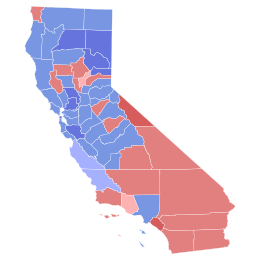 County Results Cranston: 40-50% 50–60% 60–70% Rafferty: 40–50% 50–60% 60–70% | |||||||||||||||||
| |||||||||||||||||
California was generally considered to be a Republican stronghold throughout the early 1900s. Until 1959, Republicans controlled most government offices as well as both houses of state government. However, Pat Brown was elected governor in 1958 and ushered in a wave of Democratic success.
Along with California Secretary of State Frank M. Jordan, incumbent U.S. Senator Thomas Kuchel was one of the last Republicans elected from California at the state or U.S. Senate level. Kuchel had been re-elected by a wide margin in 1962, winning every county in the state, and was the Minority Whip for the Republican Party.
However, in 1968 he faced a primary challenge from California Superintendent of Public Instruction Max Rafferty, who ran to the right of moderate Kuchel. In an upset, Rafferty defeated Kuchel in the primary, 50-47%.
In the Democratic primary, former California State Controller Alan Cranston won the primary with 58% of the vote.
Despite Richard Nixon's concurrent win in the presidential election (as well as in the state of California), Cranston defeated Rafferty on election day with just under 52% of the vote, flipping the state's other senate seat to the Democrats. Rafferty took just under 47% of the vote. Cranston would serve until 1993 in the senate.
| Party | Candidate | Votes | % | |
|---|---|---|---|---|
| Democratic | Alan Cranston | 3,615,261 | 51.78 | |
| Republican | Max Rafferty | 3,275,679 | 46.91 | |
| Peace and Freedom | Paul Jacobs | 91,254 | 1.31 | |
| Majority | 339,582 | 4.87 | ||
| Turnout | 6,982,194 | |||
| Democratic gain from Republican | ||||
Colorado
[edit]This article needs additional citations for verification. (June 2020) |
| |||||||||||||||||
 County results Dominick: 50–60% 60–70% 70–80% McNichols: 50–60% 60–70% | |||||||||||||||||
| |||||||||||||||||
Incumbent Republican Peter Dominick won election in 1962 over Democratic incumbent John A. Carroll by eight percentage points. In 1968, he increased his margin of victory against Stephen McNichols in what would be his last U.S. Senate victory. He would lose in 1974 to Gary Hart.
| Party | Candidate | Votes | % | |
|---|---|---|---|---|
| Republican | Peter H. Dominick (Incumbent) | 459,952 | 58.55 | |
| Democratic | Stephen L. R. McNichols | 325,584 | 41.45 | |
| Majority | 134,368 | 17.10 | ||
| Turnout | 785,536 | |||
| Republican hold | ||||
Connecticut
[edit]This article needs additional citations for verification. (June 2020) |
| |||||||||||||||||
Ribicoff: 50–60% 60-70% 70-80% May: 50-60% 60-70% 70-80% | |||||||||||||||||
| |||||||||||||||||
Incumbent Abraham Ribicoff was elected in 1962 after the retirement of Prescott Bush by a razor-thin 51–49 margin. He increased his margin of victory in 1968 over Republican Representative Edwin H. May Jr.
| Party | Candidate | Votes | % | |
|---|---|---|---|---|
| Democratic | Abraham Ribicoff (Incumbent) | 655,043 | 54.29 | |
| Republican | Edwin H. May Jr. | 551,455 | 45.71 | |
| None | Scattering | 39 | 0.00 | |
| Majority | 103,588 | 8.58 | ||
| Turnout | 1,206,537 | |||
| Democratic hold | ||||
Florida
[edit]
| |||||||||||||||||
 County Results
Gurney: 50–60% 60–70% 70–80% Collins: 50–60% 60–70% | |||||||||||||||||
| |||||||||||||||||
Incumbent Democrat George Smathers retired. After supporting Republicans during Reconstruction, Florida supported almost only Democrats down-ballot until the 1940s, when the state voted for Eisenhower. Claude R. Kirk Jr. was elected governor in 1966 as Republicans gained ground in the South due to Democrats shifting leftward and Republicans rightward.
Popular Democrat LeRoy Collins defeated State Attorney General Earl Faircloth in the Democratic primary, while Republican Representative Edward Gurney won the Republican primary. Despite less name recognition in the state, Gurney defeated Collins by 11 points and won all but five counties.
| Party | Candidate | Votes | % | |
|---|---|---|---|---|
| Republican | Edward J. Gurney | 1,131,499 | 55.90 | |
| Democratic | LeRoy Collins | 892,637 | 44.10 | |
| Majority | 238,862 | 11.80 | ||
| Turnout | 2,024,136 | |||
| Republican gain from Democratic | ||||
Georgia
[edit]
| |||||||||||||||||
 County results Talmadge: 50–60% 60–70% 70–80% 80–90% >90% Patton: 50-60% | |||||||||||||||||
| |||||||||||||||||
Democrat Herman Talmadge handily won re-election over Republican E. Earl Patton, who won the first-ever Republican primary in Georgia for U.S. Senate.
| Party | Candidate | Votes | % | |
|---|---|---|---|---|
| Democratic | Herman Talmadge (Incumbent) | 885,093 | 77.50 | |
| Republican | E. Earl Patton | 256,796 | 22.49 | |
| Write-in | Write-Ins | 95 | 0.01 | |
| Majority | 628,297 | 55.01 | ||
| Turnout | 1,141,984 | |||
| Democratic hold | ||||
Talmadge sought another term to the Senate and was easily re-elected. The election was notable for the Georgia Republican Party, as it marked the first U.S. Senate election where it fielded a candidate. Patton lost by over 50% to Talmadge.
Hawaii
[edit]
| |||||||||||||||||
 County results Inouye: 80–90% | |||||||||||||||||
| |||||||||||||||||
Incumbent Daniel Inouye handily won re-election against Republican Wayne C. Thiessen with 83% of the vote.
| Party | Candidate | Votes | % | |
|---|---|---|---|---|
| Democratic | Daniel Inouye (Incumbent) | 189,248 | 83.40 | |
| Republican | Wayne C. Thiessen | 34,008 | 14.99 | |
| Peace and Freedom | Oliver M. Lee | 3,671 | 1.62 | |
| Majority | 155,240 | 68.41 | ||
| Turnout | 226,927 | |||
| Democratic hold | ||||
Idaho
[edit]
| |||||||||||||||||
 County results Church: 50–60% 60–70% 70–80% 80–90% Hansen: 50–60% | |||||||||||||||||
| |||||||||||||||||
Incumbent Democrat Frank Church won re-election by a wide margin against George V. Hansen despite the state's overall Republican trend.
| Party | Candidate | Votes | % | |
|---|---|---|---|---|
| Democratic | Frank Church (Incumbent) | 173,482 | 60.26 | |
| Republican | George V. Hansen | 114,394 | 39.74 | |
| Majority | 59,088 | 20.52 | ||
| Turnout | 287,876 | |||
| Democratic hold | ||||
Illinois
[edit]
| |||||||||||||||||
 County results Dirksen: 50-60% 60-70% 70-80% Clark: 50–60% | |||||||||||||||||
| |||||||||||||||||
Incumbent Republican and Minority Leader Everett Dirksen won re-election to his fourth term over William G. Clark (D), the Illinois Attorney General. He would not serve the entirety of his term as he would die in 1970.
| Party | Candidate | Votes | % | |
|---|---|---|---|---|
| Republican | Everett Dirksen (Incumbent) | 2,358,947 | 53.01 | |
| Democratic | William G. Clark | 2,073,242 | 46.59 | |
| Socialist Labor | Louis Fisher | 17,542 | 0.39 | |
| Independent | Write-in candidates | 26 | 0.00 | |
| Invalid or blank votes | ||||
| Total votes | 4,449,757 | 100.00 | ||
| Turnout | ||||
| Republican hold | ||||
Indiana
[edit]
| |||||||||||||||||
 County results Bayh: 50–60% 60–70% Ruckelshaus: 40–50% 50–60% 60-70% | |||||||||||||||||
| |||||||||||||||||
Incumbent Democrat Birch Bayh was elected in 1962, defeating incumbent Republican Homer E. Capehart by around 11,000 votes. In 1970, he ran for re-election and faced Republican State Representative William Ruckelshaus in the general election.
Ruckelshaus ran a close race but Bayh was ultimately re-elected by a two-point margin. This would actually be Bayh's largest vote percentage in an election to the U.S. Senate. In 1974, he won a narrow majority of the vote over Republican Richard Lugar though he did increase his margin of victory. He was defeated in his re-election bid in 1980 by future Vice President Dan Quayle.
Birch Bayh's son Evan Bayh would also serve in the U.S. Senate from 1999 to 2011.
| Party | Candidate | Votes | % | |
|---|---|---|---|---|
| Democratic | Birch Bayh (Incumbent) | 1,060,456 | 51.65 | |
| Republican | William Ruckelshaus | 988,571 | 48.15 | |
| Prohibition | L. Earl Malcolm | 2,844 | 0.14 | |
| Socialist Workers | Ralph Levitt | 1,247 | 0.06 | |
| Majority | 71,885 | 3.50 | ||
| Turnout | 2,053,118 | |||
| Democratic hold | ||||
Iowa
[edit]
| |||||||||||||||||
| |||||||||||||||||
 County results Hughes: 50–60% 60–70% Stanley: 50-60% 60-70% 70-80% | |||||||||||||||||
| |||||||||||||||||
Four-term Republican Bourke B. Hickenlooper retired. Two-term Democratic Governor of Iowa Harold Hughes was elected senator in a close race against Republican state senator David M. Stanley.
| Party | Candidate | Votes | % | |
|---|---|---|---|---|
| Democratic | Harold Hughes | 574,884 | 50.25 | |
| Republican | David M. Stanley | 568,469 | 49.69 | |
| Prohibition | Uerne M. Higens | 727 | 0.06 | |
| None | Scattering | 6 | 0.00 | |
| Majority | 6,415 | 0.56 | ||
| Turnout | 1,144,086 | 41.52 | ||
| Democratic gain from Republican | ||||
Kansas
[edit]
| |||||||||||||||||
 County results Dole: 50-60% 60-70% 70-80% Robinson: 50–60% | |||||||||||||||||
| |||||||||||||||||
Incumbent Republican Frank Carlson chose to retire rather than seek re-election. Republican Bob Dole defeated Democrat William Robinson with 60% of the vote and won all but one county in the state. Still, this would be his second-worst U.S. Senate election performance after 1974 in the wake of Watergate.
| Party | Candidate | Votes | % | |
|---|---|---|---|---|
| Republican | Bob Dole | 490,911 | 60.08 | |
| Democratic | William I. Robinson | 315,911 | 38.66 | |
| Prohibition | Joseph Fred Hyskell | 10,262 | 1.26 | |
| None | Scattering | 12 | 0.00 | |
| Majority | 175,000 | 21.42 | ||
| Turnout | 817,096 | |||
| Republican hold | ||||
Kentucky
[edit]
| |||||||||||||||||
 County results Cook: 40-50% 50-60% 60-70% 70-80% 80–90% Peden: 40–50% 50–60% 60–70% 70–80% | |||||||||||||||||
| |||||||||||||||||
Though originally voting strongly Democratic like the rest of the South after Reconstruction, Kentucky began electing Republicans in the 1890s but still leaned Democratic. Still, Republicans found success with the elections to U.S. Senate of Thruston Ballard Morton and John Sherman Cooper. Morton decided to retire in 1968, creating an open seat. Republican Marlow Cook narrowly defeated Democrat Katherine Peden by a 51–48 margin.
| Party | Candidate | Votes | % | |
|---|---|---|---|---|
| Republican | Marlow Cook | 484,260 | 51.36 | |
| Democratic | Katherine Peden | 448,960 | 47.62 | |
| American Independent | Duane F. Olsen | 9,645 | 1.02 | |
| Majority | 35,300 | 3.74 | ||
| Turnout | 942,865 | |||
| Republican hold | ||||
Louisiana
[edit]
| |||||||||||||||||
| |||||||||||||||||
 Parish results Long: 60–70% 70–80% 80–90% >90% Blache: 60–70% | |||||||||||||||||
| |||||||||||||||||
Incumbent Democrat Russell B. Long ran unopposed for U.S. Senate and was re-elected.
| Party | Candidate | Votes | % | |
|---|---|---|---|---|
| Democratic | Russell B. Long (Incumbent) | 518,586 | 100.00 | |
| Democratic hold | ||||
Maryland
[edit]
| |||||||||||||||||||||
 County results Mathias: 30–40% 40–50% 50–60% 60–70% Brewster: 30–40% 40–50% 50–60% | |||||||||||||||||||||
| |||||||||||||||||||||
Incumbent Democrat Daniel Brewster was originally elected in 1962 over Republican Representative Edward Tylor Miller. He won the Democratic primary and faced Republican Representative Charles Mathias in the general election. However, Democrat George P. Mahoney ran in the election under the American Independent Party. Mahoney, who ran against the Civil Rights movement, had previously been the Democratic nominee for governor in 1966 losing to Spiro Agnew. Hyman A. Pressman ran an independent campaign which allowed Republican Agnew to carry the heavily Democratic state with 49.5% of the vote.
Similarly, Mahoney ran a well-funded campaign in 1968 and Brewster was defeated in the general election. Mathias won just 48% of the vote to 39% for Brewster (and 13% for Mahoney), similarly elected to Agnew. Mathias would nonetheless have no trouble being re-elected in 1974 and 1980 (when he won the city of Baltimore). Mathias is the last Republican to represent Maryland in the U.S. Senate.
| Party | Candidate | Votes | % | |
|---|---|---|---|---|
| Republican | Charles Mathias | 541,893 | 47.78 | |
| Democratic | Daniel B. Brewster (Incumbent) | 443,667 | 39.12 | |
| American Independent | George P. Mahoney | 148,467 | 13.09 | |
| Majority | 98,226 | 8.66 | ||
| Turnout | 1,134,027 | |||
| Republican gain from Democratic | ||||
Missouri
[edit]
| |||||||||||||||||
| |||||||||||||||||
 County results Long: 50–60% 60–70% Curtis: 50–60% 60–70% 70–80% | |||||||||||||||||
| |||||||||||||||||
Incumbent U.S. Senator Edward V. Long ran for re-election but faced two primary challengers in Lieutenant Governor Thomas Eagleton and former Assistant Secretary of the Treasury W. True Davis Jr., who each ran strong campaigns. Eagleton won the primary with 37% of the vote.
In the general election, Eagleton faced Republican Representative Thomas B. Curtis and won a close-fought election with 51% of the vote to 49% for Curtis. Eagleton would be re-elected over Curtis again in 1974.
| Party | Candidate | Votes | % | |
|---|---|---|---|---|
| Democratic | Thomas Eagleton | 880,113 | 51.01 | |
| Republican | Thomas B. Curtis | 845,144 | 48.99 | |
| Majority | 34,969 | 2.02 | ||
| Turnout | 1,725,257 | |||
| Democratic hold | ||||
Nevada
[edit]
| |||||||||||||||||
| |||||||||||||||||
 County results Bible: 50–60% 60–70% Fike: 50–60% | |||||||||||||||||
| |||||||||||||||||
Incumbent Alan Bible was originally elected in 1954 in a special election over Republican Ernest S. Brown. He narrowly defeated Republican Clarence Clifton Young in 1956 and won by a landslide in 1962. He defeated Republican Edward Fike by a smaller margin of 55–45 in 1968 in what would be his last term.
| Party | Candidate | Votes | % | |
|---|---|---|---|---|
| Democratic | Alan Bible (Incumbent) | 83,622 | 54.76 | |
| Republican | Edward Fike | 69,083 | 45.24 | |
| Majority | 14,539 | 9.52 | ||
| Turnout | 152,705 | |||
| Democratic hold | ||||
New Hampshire
[edit]
| |||||||||||||||||
| |||||||||||||||||
 County results Cotton: 50-60% 60-70% 70-80% King: 50–60% | |||||||||||||||||
| |||||||||||||||||
Incumbent Norris Cotton handily won re-election against incumbent Governor John W. King in what would be his final term.
| Party | Candidate | Votes | % | |
|---|---|---|---|---|
| Republican | Norris Cotton (Incumbent) | 170,163 | 59.29 | |
| Democratic | John W. King | 116,816 | 40.70 | |
| Write-in | 10 | 0.00 | ||
| Majority | 53,347 | 18.59 | ||
| Turnout | 286,989 | |||
| Republican hold | ||||
New York
[edit]
| |||||||||||||||||||||
| |||||||||||||||||||||
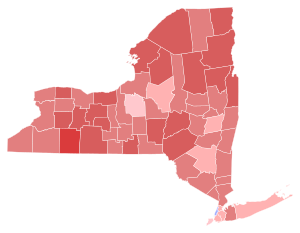 County results Javits: 30–40% 40–50% 50–60% 60–70% 70–80% O'Dwyer: 40–50% | |||||||||||||||||||||
| |||||||||||||||||||||
Incumbent Republican Jacob Javits won against Democratic challenger Paul O'Dwyer and Conservative Party challenger James L. Buckley in a three-way election.
While Javits did not face any challengers for the Republican nomination, he did face a minor one when seeking the Liberal Party of New York's nomination.
| Party | Candidate | Votes | % | |
|---|---|---|---|---|
| Democratic | Paul O'Dwyer | 275,877 | 36.14 | |
| Democratic | Eugene Nickerson | 257,639 | 33.75 | |
| Democratic | Joseph Y. Resnick | 229,893 | 30.11 | |
| Total votes | 763,409 | 100.00 | ||
| Party | Candidate | Votes | % | |
|---|---|---|---|---|
| Liberal | Jacob Javits (Incumbent) | 10,277 | 72.14 | |
| Liberal | Murray Baron | 3,969 | 27.86 | |
| Total votes | 14,246 | 100.00 | ||
| Party | Candidate | Votes | % | |
|---|---|---|---|---|
| Republican | Jacob Javits (Incumbent) | 2,810,836 | ||
| Liberal | Jacob Javits | 458,936 | ||
| Republican + Liberal Party | Jacob Javits | 3,269,772 | 49.68 | |
| Democratic | Paul O'Dwyer | 2,150,695 | 32.68 | |
| Conservative | James L. Buckley | 1,139,402 | 17.31 | |
| Peace and Freedom | Herman Ferguson | 8,775 | 0.13 | |
| Socialist Labor | John Emanuel | 7,964 | 0.12 | |
| Socialist Workers | Hedda Garza | 4,979 | 0.08 | |
| Majority | 1,119,113 | 17.00 | ||
| Turnout | 6,581,551 | 39.22 | ||
| Republican hold | ||||
North Carolina
[edit]
| |||||||||||||||||
| |||||||||||||||||
 County results Ervin: 50–60% 60–70% 70–80% 80–90% >90% Somers: 50–60% 60–70% 70–80% | |||||||||||||||||
| |||||||||||||||||
The general election was fought between the Democratic incumbent Sam Ervin and the Republican nominee Robert Somers. Ervin won re-election to a third full term, with over 60% of the vote.
The first round of the Primary Election was held on May 4, 1968.[13] The runoff for the Republican Party candidates took place on June 1.[14]
| Party | Candidate | Votes | % | |
|---|---|---|---|---|
| Democratic | Sam Ervin (incumbent) | 499,392 | 82.12 | |
| Democratic | Charles Pratt | 60,362 | 9.90 | |
| Democratic | John Gathings | 48,357 | 7.95 | |
| Turnout | 608,111 | |||
| Party | Candidate | Votes | % | |
|---|---|---|---|---|
| Republican | Robert Somers | 48,351 | 36.63 | |
| Republican | J. L. Zimmerman | 43,644 | 33.06 | |
| Republican | B. E. Sweatt | 40,023 | 30.32 | |
| Turnout | 132,018 | |||
| Party | Candidate | Votes | % | |
|---|---|---|---|---|
| Republican | Robert Somers | 8,816 | 60.59 | |
| Republican | J. L. Zimmerman | 5,734 | 39.41 | |
| Turnout | 14,550 | |||
| Party | Candidate | Votes | % | |
|---|---|---|---|---|
| Democratic | Sam Ervin (Incumbent) | 870,406 | 60.56 | |
| Republican | Robert Somers | 566,834 | 39.44 | |
| Majority | 303,572 | 21.12 | ||
| Turnout | 901,978 | |||
| Democratic hold | ||||
North Dakota
[edit]
| |||||||||||||||||
| |||||||||||||||||
 County results Young: 50-60% 60-70% 70-80% 80-90% | |||||||||||||||||
| |||||||||||||||||
North Dakota Republican Milton Young, sought and received re-election to his fifth term, defeating North Dakota Democratic-NPL Party candidate Herschel Lashkowitz, the mayor of Fargo, North Dakota since 1954.[1][15]
Only Young filed as a Republican, and the endorsed Democratic candidate was Herschel Lashkowitz of Fargo, North Dakota, who was serving as the mayor of the city since 1954. Young and Lashkowitz won the primary elections for their respective parties.
One independent candidate, Duane Mutch of Larimore, North Dakota, also filed before the deadline. Mutch was later a state senator for the North Dakota Republican Party in the North Dakota Senate from 1959 to 2006 for District 19. He ran as an independent when he did not receive his party's nomination.
| Party | Candidate | Votes | % | |
|---|---|---|---|---|
| Republican | Milton R. Young (incumbent) | 154,968 | 64.79 | |
| Democratic–NPL | Herschel Lashkowitz | 80,815 | 33.79 | |
| Independent | Duane Mutch | 3,393 | 1.42 | |
| Turnout | 239,176 | |||
| Republican hold | ||||
Ohio
[edit]
| |||||||||||||||||
| |||||||||||||||||
 County results Saxbe: 50–60% 60–70% 70–80% | |||||||||||||||||
| |||||||||||||||||
Incumbent Democrat Frank J. Lausche ran for re-election but was defeated in the primary by Representative John J. Gilligan, who criticized Lausche's conservative voting record. Republican State Attorney General of Ohio William Saxbe won the Republican primary and defeated Gilligan in the general election by a 51–48 margin. He would not serve out his term after resigning to become United States Attorney general in 1974.
| Party | Candidate | Votes | % | |
|---|---|---|---|---|
| Republican | William B. Saxbe | 1,928,964 | 51.53 | |
| Democratic | John J. Gilligan | 1,814,152 | 48.47 | |
| None | Write-Ins | 4 | 0.00 | |
| Majority | 114,812 | 3.06 | ||
| Turnout | 3,743,120 | |||
| Republican gain from Democratic | ||||
Oklahoma
[edit]
| |||||||||||||||||
| |||||||||||||||||
 County results Bellmon: 40-50% 50-60% 60-70% 70-80% Monroney: 40–50% 50–60% 60–70% | |||||||||||||||||
| |||||||||||||||||
Incumbent Democratic U.S. senator Mike Monroney was running for re-election to a fourth term, but was defeated by Republican former Governor Henry Bellmon.
| Party | Candidate | Votes | % | |
|---|---|---|---|---|
| Republican | Henry Bellmon | 470,120 | 51.7 | |
| Democratic | Mike Monroney (Incumbent) | 419,658 | 46.2 | |
| American Independent | George Washington | 19,341 | 2.1 | |
| Majority | 50,462 | 5.55 | ||
| Turnout | 909,119 | |||
| Republican gain from Democratic | ||||
Oregon
[edit]
| |||||||||||||||||
| |||||||||||||||||
 County results Packwood: 50-60% 60-70% Morse: 50–60% | |||||||||||||||||
| |||||||||||||||||
Incumbent Democrat Wayne Morse was seeking a fifth term, but narrowly lost re-election to 36-year-old Republican State Representative Bob Packwood race.[17]
The Democratic primary was held May 28, 1968.[18] Morse defeated former Representative Robert B. Duncan, former U.S. Congressman from Oregon's 4th congressional district (1963–1967), and Phil McAlmond, millionaire and former aide to opponent Robert B. Duncan.
| Party | Candidate | Votes | % | |
|---|---|---|---|---|
| Democratic | Wayne Morse (Incumbent) | 185,091 | 49.03 | |
| Democratic | Robert B. Duncan | 174,795 | 46.30 | |
| Democratic | Phil McAlmond | 17,658 | 4.68 | |
| Total votes | 377,544 | 100.00 | ||
| Party | Candidate | Votes | % | |||
|---|---|---|---|---|---|---|
| Republican | Bob Packwood | 408,646 | 50.20 | |||
| Democratic | Wayne Morse (Incumbent) | 405,353 | 49.80 | |||
| Total votes | 813,999 | 100.00 | ||||
| Republican gain from Democratic | ||||||
Pennsylvania
[edit]
| |||||||||||||||||
| |||||||||||||||||
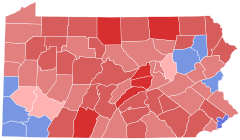 County results
Schweiker: 40–50% 50–60% 60–70% 70–80% Clark: 50–60% 60–70% | |||||||||||||||||
| |||||||||||||||||
Incumbent Democrat Joseph Clark sought re-election to another term, but was defeated by Republican nominee Richard Schweiker, member of the U.S. House of Representatives.
| Party | Candidate | Votes | % | |
|---|---|---|---|---|
| Republican | Richard Schweiker | 2,399,762 | 51.90 | |
| Democratic | Joseph Clark (Incumbent) | 2,117,662 | 45.80 | |
| Constitution | Frank W. Gaydosh | 96,742 | 2.09 | |
| Socialist Labor | Benson Perry | 7,198 | 0.16 | |
| Socialist Workers | Pearl Chertov | 2,743 | 0.06 | |
| Other | Other | 111 | 0.00 | |
| Majority | 282,100 | 6.10 | ||
| Turnout | 4,624,218 | |||
| Republican gain from Democratic | ||||
South Carolina
[edit]
| |||||||||||||||||
| |||||||||||||||||
 County results Hollings: 50–60% 60–70% 70–80% | |||||||||||||||||
| |||||||||||||||||
Incumbent Democrat Fritz Hollings easily defeated Republican state senator Marshall Parker in a rematch of the election two years earlier, to win his second (his first full) term.
Hollings faced no opposition from South Carolina Democrats, and avoided a primary election. Marshall Parker, the state senator from Oconee County in the Upstate, was persuaded by South Carolina Republicans to enter the race, and he did not face a primary challenge.
After a close election loss to Fritz Hollings in 1966, the Republicans felt that Parker might have a chance at defeating Hollings by riding Nixon's coattails in the general election. However, the Republicans did not provide Parker with the financial resources to compete, and he subsequently lost by a bigger margin to Hollings than two years prior.
| Party | Candidate | Votes | % | |
|---|---|---|---|---|
| Democratic | Fritz Hollings (incumbent) | 404,060 | 61.9 | |
| Republican | Marshall Parker | 248,780 | 38.1 | |
| Write-in | Write-Ins | 15 | 0.0 | |
| Majority | 155,280 | 23.8 | ||
| Turnout | 652,855 | 76.5 | ||
| Democratic hold | ||||
South Dakota
[edit]
| |||||||||||||||||
| |||||||||||||||||
 County results McGovern: 50–60% 60–70% 70–80% Gubbrud: 50–60% 60–70% 70–80% | |||||||||||||||||
| |||||||||||||||||
Incumbent Democrat George McGovern had flirted with presidential aspirations in 1968 but ultimately decided to run for re-election, defeating Republican Archie M. Gubbrud by a comfortable margin.
| Party | Candidate | Votes | % | |
|---|---|---|---|---|
| Democratic | George McGovern (Incumbent) | 158,961 | 56.79 | |
| Republican | Archie M. Gubbrud | 120,951 | 43.21 | |
| Majority | 38,010 | 13.58 | ||
| Turnout | 279,912 | |||
| Democratic hold | ||||
Utah
[edit]
| |||||||||||||||||
| |||||||||||||||||
 County results Bennett: 50–60% 60–70% 70–80% Weilenmann: 40–50% 50–60% 60–70% Tie: 40–50% | |||||||||||||||||
| |||||||||||||||||
Incumbent Wallace F. Bennett, a Republican, won re-election to a fourth term in the U.S. Senate by a comfortable margin against Democrat Milton Weilemann.
| Party | Candidate | Votes | % | |
|---|---|---|---|---|
| Republican | Wallace F. Bennett (Incumbent) | 225,075 | 53.68 | |
| Democratic | Milton N. Weilenmann | 192,168 | 45.83 | |
| Peace and Freedom | Utah Phillips | 2,019 | 0.48 | |
| Majority | 32,907 | 7.85 | ||
| Turnout | 419,262 | |||
| Republican hold | ||||
Vermont
[edit]
| ||||||||||||||||||||
| ||||||||||||||||||||
County results Aiken: 90–100% | ||||||||||||||||||||
| ||||||||||||||||||||
Incumbent Republican George Aiken ran successfully for re-election to another term in the United States Senate. Vermont voted Democratic for the first time since the 1850s for Lyndon B. Johnson in 1964. Vermont also elected Democrat Philip H. Hoff in 1962, and he served until 1969. Hoff ran a write-in campaign in the Democratic primary for this seat but lost to Republican Aiken by a wide margin. Aiken thus ran with both nominations and secured a victory. This would be once staunchly-Republican Vermont's last time to support a Republican for this seat. In 1974, Patrick Leahy would win and become the first Democratic Senator from Vermont.
| Party | Candidate | Votes | % | |
|---|---|---|---|---|
| Republican | George Aiken (Incumbent) | 42,248 | 72.8 | |
| Republican | William K. Tufts | 15,786 | 27.2 | |
| Republican | Other | 28 | 0.0 | |
| Total votes | 58,062 | 100.0 | ||
| Party | Candidate | Votes | % | |
|---|---|---|---|---|
| Write-In | George Aiken (Incumbent) | 1,534 | 61.8 | |
| Write-In | Philip H. Hoff | 400 | 18.2 | |
| Democratic | Other | 438 | 20.0 | |
| Total votes | 2,192 | 100.0 | ||
| Party | Candidate | Votes | % | |
|---|---|---|---|---|
| Republican | George Aiken (Incumbent) | 94,738 | 60.2 | |
| Democratic | George Aiken (Incumbent) | 62,416 | 39.7 | |
| Independent | George Aiken (Incumbent) | 43 | 0.0 | |
| Republican + Democratic + Independent | George Aiken (Incumbent) | 157,197 | 99.9 | |
| N/A | Other | 178 | 0.1 | |
| Total votes | 157,375 | 100.0 | ||
| Republican hold | ||||
Washington
[edit]
| |||||||||||||||||
| |||||||||||||||||
 County results Magnuson: 50–60% 60–70% 70–80% Metcalf: 50–60% | |||||||||||||||||
| |||||||||||||||||
Incumbent Warren G. Magnuson won re-election by a wide margin against his Republican opponent Metcalf.
| Party | Candidate | Votes | % | |
|---|---|---|---|---|
| Democratic | Warren G. Magnuson (Incumbent) | 796,183 | 64.41 | |
| Republican | Jack Metcalf | 435,894 | 35.26 | |
| New Party | Irwin R. Hogenauer | 2,762 | 0.22 | |
| Socialist Workers | Debbie Leonard | 1,224 | 0.10 | |
| Majority | 360,289 | 29.15 | ||
| Turnout | 1,236,063 | |||
| Democratic hold | ||||
Wisconsin
[edit]
| |||||||||||||||||
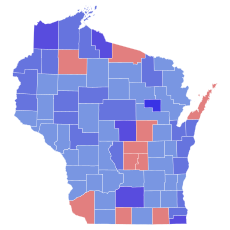 County results Nelson: 50–60% 60–70% 70–80% 80–90% Leonard: 50-60% | |||||||||||||||||
| |||||||||||||||||
Incumbent Democrat Gaylord A. Nelson (U.S. senator since 1963) defeated Republican State Senator Jerris Leonard.
| Party | Candidate | Votes | % | |
|---|---|---|---|---|
| Democratic | Gaylord Nelson (Incumbent) | 1,020,931 | 61.69 | |
| Republican | Jerris Leonard | 633,910 | 38.31 | |
| Write-in | Write-ins | 20 | 0.00 | |
| Majority | 387,021 | 23.38 | ||
| Turnout | 1,654,861 | |||
| Democratic hold | ||||
See also
[edit]Notes
[edit]- ^ a b c Reflecting the result of the November 1968 elections, only. Following those elections, upon the death of Alaska Democratic Senator Bob Bartlett and subsequent appointment of Republican Ted Stevens, the partisan balance at the beginning of the 91st United States Congress stood at 57–43 in favor of the Democrats.
- ^ a b The Liberal Party in New York nominated Jacob Javits, a Republican, but the Clerk of the U.S. House of Representatives did not tabulate their votes, totaling 458,936, into the national Republican total.[1]
- ^ a b c d e f g h i j k l m n o p q r s t u v w x y z aa Clerk of the U.S. House of Representatives (July 1, 1969). "Statistics of the Presidential and Congressional Election of November 5, 1968" (PDF). U.S. Government Printing Office. p. 54.
- ^ "Milton Weilenmann - Obituary". www.legacy.com. Retrieved September 10, 2020.
- ^ Warren Weaver Jr. (July 2, 1971). "Impetuous Senator: Maurice Robert Gravel" (fee required). The New York Times. Retrieved December 24, 2007.
- ^ "Our Campaigns - AK US Senate Race - Nov 05, 1968". www.ourcampaigns.com. Retrieved September 9, 2020.
- ^ "AZ US Senate - D Primary Race - Sep 10, 1968". Our Campaigns. Retrieved December 19, 2017.
- ^ "AZ US Senate Race - Nov 05, 1968". Our Campaigns. Retrieved December 19, 2017.
- ^ "1968 Senatorial General Election Results - Illinois".
- ^ "Our Campaigns - IA US Senate Race - Nov 05, 1968".
- ^ "NH US Senate, 1968". Our Campaigns. Retrieved July 12, 2021.
- ^ "NY US Senate - D Primary Race - Jun 18, 1968". Our Campaigns. Retrieved December 19, 2017.
- ^ "NY US Senate - L Primary Race - Jun 18, 1968". Our Campaigns. Retrieved December 19, 2017.
- ^ "NY US Senate Race - Nov 05, 1968". Our Campaigns. Retrieved December 19, 2017.
- ^ "NC US Senate - D Primary Race - May 04, 1968". Our Campaigns. Retrieved December 19, 2017.
- ^ "NC US Senate - R Runoff Race - Jun 01, 1968". Our Campaigns. Retrieved December 19, 2017.
- ^ "Lashkowitz's storied tenure". Archived from the original on May 16, 2008. Retrieved August 17, 2017.
- ^ "OK US Senate Race - Nov 05, 1968". Our Campaigns. Retrieved December 19, 2017.
- ^ a b "OR US Senate" – via OurCampaigns.com.
- ^ a b "OR US Senate - D Primary" – via OurCampaigns.com.
- ^ a b "Primary Election Results" (PDF). Office of the Vermont Secretary of State. Archived from the original (PDF) on March 3, 2016. Retrieved June 17, 2015.
- ^ "General Election Results - U.S. senator - 1914-2014" (PDF). Office of the Vermont Secretary of State. Archived from the original (PDF) on March 4, 2016. Retrieved June 17, 2015.
References
[edit]- "Supplemental Report of the Secretary of State to the General Assembly of South Carolina." Reports and Resolutions of South Carolina to the General Assembly of the State of South Carolina. Volume II. Columbia, SC: 1969, p. 19.
- Kalk, Bruce H. (2001). The Origins of the Southern Strategy: Two-Party Competition in South. Lexington Books. p. 86.

